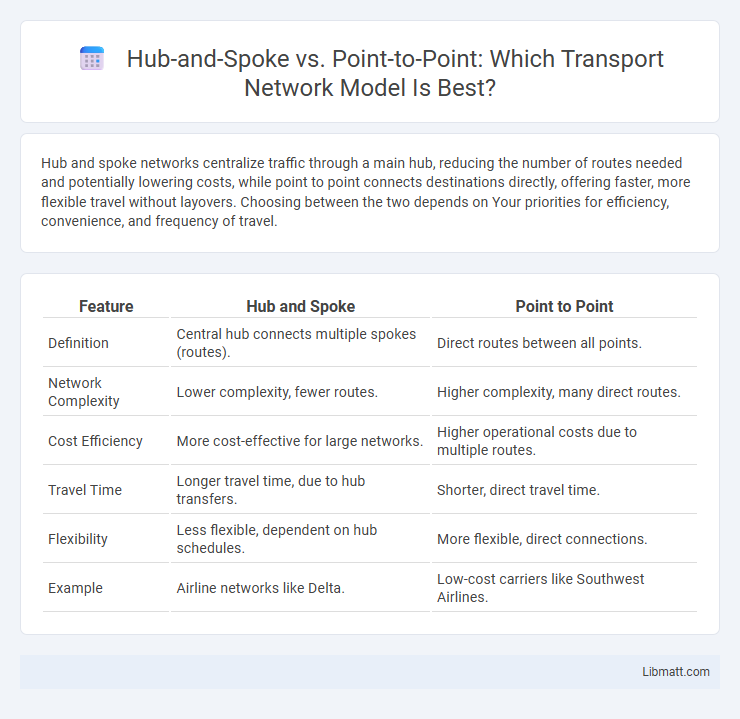Hub and spoke networks centralize traffic through a main hub, reducing the number of routes needed and potentially lowering costs, while point to point connects destinations directly, offering faster, more flexible travel without layovers. Choosing between the two depends on Your priorities for efficiency, convenience, and frequency of travel.
Table of Comparison
| Feature | Hub and Spoke | Point to Point |
|---|---|---|
| Definition | Central hub connects multiple spokes (routes). | Direct routes between all points. |
| Network Complexity | Lower complexity, fewer routes. | Higher complexity, many direct routes. |
| Cost Efficiency | More cost-effective for large networks. | Higher operational costs due to multiple routes. |
| Travel Time | Longer travel time, due to hub transfers. | Shorter, direct travel time. |
| Flexibility | Less flexible, dependent on hub schedules. | More flexible, direct connections. |
| Example | Airline networks like Delta. | Low-cost carriers like Southwest Airlines. |
Introduction to Hub and Spoke vs Point to Point
Hub and Spoke and Point to Point are two primary network architectures widely used in transportation and logistics. Hub and Spoke centralizes routes through a main hub, optimizing efficiency and reducing costs by consolidating traffic, while Point to Point connects destinations directly, offering faster travel times and increased flexibility. Your choice between these models depends on factors like volume, distance, and operational priorities.
Understanding the Hub and Spoke Model
The Hub and Spoke model centralizes connections through a main hub, streamlining routes and improving efficiency by consolidating traffic. This approach reduces costs and simplifies logistics compared to Point-to-Point models, which require direct connections between every pair of nodes. Understanding this system helps you optimize network design for scalability and resource management.
Point to Point Network Explained
Point to Point network architecture establishes direct connections between individual nodes, minimizing latency and enhancing communication speed by bypassing centralized hubs. This topology is ideal for high-traffic routes where dedicated bandwidth and reliability are critical, such as airline routes or private data links. Although it requires more infrastructure and management compared to hub and spoke systems, Point to Point networks deliver consistent performance and reduce single points of failure.
Key Differences Between Hub and Spoke and Point to Point
Hub and spoke networks centralize connections through a main hub, reducing the number of direct routes required and optimizing resource allocation, while point-to-point networks establish direct connections between every node, offering faster communication but higher operational costs. Hub and spoke models are efficient for airlines and logistics, minimizing complexity and downtime, whereas point-to-point architectures excel in scenarios demanding low latency and high reliability, such as specialized telecommunications. The choice between them hinges on factors like network size, cost constraints, and performance requirements, with hub and spoke favoring scalability and manageability, and point-to-point enhancing speed and direct access.
Advantages of the Hub and Spoke System
The Hub and Spoke system centralizes operations, allowing for efficient resource allocation and simplified management at the hub, which reduces overall costs. This model enhances connectivity by consolidating multiple routes through a central point, increasing frequency and route options without requiring direct links between all destinations. Your logistics or transportation network benefits from improved scalability and increased flexibility in scheduling, making it ideal for businesses handling numerous routes or destinations.
Benefits of Point to Point Networks
Point to Point networks offer direct routes between locations, resulting in lower latency and faster data transmission compared to hub and spoke architectures. This topology improves network reliability by eliminating single points of failure, enhancing consistent connectivity for critical applications. Additionally, Point to Point networks simplify traffic management and reduce bandwidth bottlenecks by maintaining dedicated links between devices or sites.
Challenges of Each Network Model
Hub and spoke networks face challenges such as potential bottlenecks at the central hub, increased dependency on hub efficiency, and limited direct connectivity causing longer travel or shipping times. Point-to-point networks struggle with high operational costs, complexity in scheduling, and difficulties in scaling as each route requires direct management. Both models require balancing cost efficiency and service quality to meet specific logistical and operational demands.
Real-World Examples: Airlines and Logistics
Hub and spoke networks dominate airline operations, with carriers like Delta Airlines using centralized hubs such as Atlanta to efficiently route passengers through major connecting points, optimizing fleet utilization and reducing costs. In contrast, point-to-point models are favored by low-cost carriers like Southwest Airlines, enabling nonstop flights between secondary cities that reduce travel time and increase convenience for passengers. Your choice between these models influences operational complexity and customer experience, especially in logistics where companies like FedEx employ hub and spoke distribution centers for consolidated shipping, while local delivery services might rely on straightforward point-to-point routes.
Choosing the Right Model for Your Business
Selecting the right model for your business depends on factors like cost efficiency, scalability, and service frequency. Hub and spoke systems centralize operations, reducing expenses while enabling broader network coverage, making them ideal for large-scale logistics. Point-to-point models offer direct routes and faster delivery times, better suited for businesses prioritizing speed and flexibility in smaller or regional markets.
Conclusion: Hub and Spoke vs Point to Point
Hub and Spoke networks centralize operations through a main hub, optimizing route efficiency and reducing overall costs, while Point to Point systems offer direct connections that enhance speed and convenience for specific routes. Your choice depends on whether you prioritize scalability and cost-effectiveness or direct, rapid service between locations. Businesses seeking broad coverage benefit from Hub and Spoke, whereas those emphasizing quick, direct access favor Point to Point models.
hub and spoke vs point to point Infographic

 libmatt.com
libmatt.com